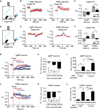Sensory detection of food rapidly modulates arcuate feeding circuits
- PMID: 25703096
- PMCID: PMC4373539
- DOI: 10.1016/j.cell.2015.01.033
Sensory detection of food rapidly modulates arcuate feeding circuits
Abstract
Hunger is controlled by specialized neural circuits that translate homeostatic needs into motivated behaviors. These circuits are under chronic control by circulating signals of nutritional state, but their rapid dynamics on the timescale of behavior remain unknown. Here, we report optical recording of the natural activity of two key cell types that control food intake, AgRP and POMC neurons, in awake behaving mice. We find unexpectedly that the sensory detection of food is sufficient to rapidly reverse the activation state of these neurons induced by energy deficit. This rapid regulation is cell-type specific, modulated by food palatability and nutritional state, and occurs before any food is consumed. These data reveal that AgRP and POMC neurons receive real-time information about the availability of food in the external world, suggesting a primary role for these neurons in controlling appetitive behaviors such as foraging that promote the discovery of food.
Copyright © 2015 Elsevier Inc. All rights reserved.
Figures







Comment in
-
The hunger games.Cell. 2015 Feb 26;160(5):805-806. doi: 10.1016/j.cell.2015.02.028. Cell. 2015. PMID: 25723156
Similar articles
-
Leptin-activated hypothalamic BNC2 neurons acutely suppress food intake.Nature. 2024 Dec;636(8041):198-205. doi: 10.1038/s41586-024-08108-2. Epub 2024 Oct 30. Nature. 2024. PMID: 39478220 Free PMC article.
-
Making sense of the sensory regulation of hunger neurons.Bioessays. 2016 Apr;38(4):316-24. doi: 10.1002/bies.201500167. Epub 2016 Feb 22. Bioessays. 2016. PMID: 26898524 Free PMC article. Review.
-
Antagonistic modulation of NPY/AgRP and POMC neurons in the arcuate nucleus by noradrenalin.Elife. 2017 Jun 20;6:e25770. doi: 10.7554/eLife.25770. Elife. 2017. PMID: 28632132 Free PMC article.
-
Arcuate hypothalamic AgRP and putative POMC neurons show opposite changes in spiking across multiple timescales.Elife. 2015 Jul 10;4:e07122. doi: 10.7554/eLife.07122. Elife. 2015. PMID: 26159614 Free PMC article.
-
The hypothalamic arcuate nucleus and the control of peripheral substrates.Best Pract Res Clin Endocrinol Metab. 2014 Oct;28(5):725-37. doi: 10.1016/j.beem.2014.03.003. Epub 2014 Apr 4. Best Pract Res Clin Endocrinol Metab. 2014. PMID: 25256767 Review.
Cited by
-
Effects of metabolic state on the regulation of melanocortin circuits.Physiol Behav. 2020 Oct 1;224:113039. doi: 10.1016/j.physbeh.2020.113039. Epub 2020 Jun 28. Physiol Behav. 2020. PMID: 32610101 Free PMC article. Review.
-
Interacting Neural Processes of Feeding, Hyperactivity, Stress, Reward, and the Utility of the Activity-Based Anorexia Model of Anorexia Nervosa.Harv Rev Psychiatry. 2016 Nov/Dec;24(6):416-436. doi: 10.1097/HRP.0000000000000111. Harv Rev Psychiatry. 2016. PMID: 27824637 Free PMC article. Review.
-
Neural Circuit Motifs in Valence Processing.Neuron. 2018 Oct 24;100(2):436-452. doi: 10.1016/j.neuron.2018.10.001. Neuron. 2018. PMID: 30359607 Free PMC article. Review.
-
Modulation of Feeding and Associated Behaviors by Lateral Hypothalamic Circuits.Endocrinology. 2018 Nov 1;159(11):3631-3642. doi: 10.1210/en.2018-00449. Endocrinology. 2018. PMID: 30215694 Free PMC article. Review.
-
Feeding neurons integrate metabolic and reproductive states in mice.iScience. 2023 Sep 14;26(10):107918. doi: 10.1016/j.isci.2023.107918. eCollection 2023 Oct 20. iScience. 2023. PMID: 37817932 Free PMC article.
References
-
- Blouet C, Schwartz GJ. Hypothalamic nutrient sensing in the control of energy homeostasis. Behavioural brain research. 2010;209:1–12. - PubMed
Publication types
MeSH terms
Substances
Grants and funding
LinkOut - more resources
Full Text Sources
Other Literature Sources
Miscellaneous

